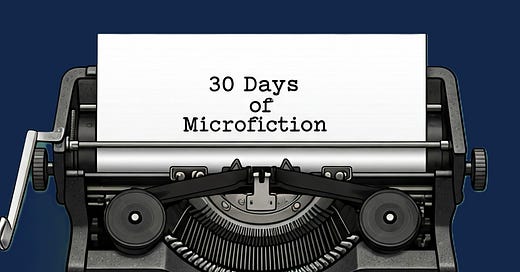The 30-Day Microfiction Challenge: Tiny Stories, Big Impact
How to beat down your bad writing habits with 100-word stories.
Want to build a consistent writing routine, boost your creativity, and launch your fiction career in just one month?
Here’s a piece of advice: don’t write a novel.
(Not yet, anyway.)
Writing a novel as a beginner is like jumping into a pool without first learning how to swim. You need to doggie paddle in the shallows before you can dive into the deep end. Otherwise, you’ll drown, along with your dreams of becoming a published author.
I don’t want that, and neither do you.
Instead, I’d like to introduce you to a different style of writing–one that will cement in you the habits and skills you need to see longer, more complex projects through to the end. It’s the strategy I used to kickstart my own writing habits not too long ago. I’ve never felt more confident in my writing than I do today—and I've been at this for a while (15 years and counting).
The best part? It’s so easy, anyone can do it.
Over the next 30 days, I’ll show you how.
Microfiction: The Key to Building Foundational Writing Skills
During the summer of 2024, I discovered a genre of writing that changed everything for me: microfiction.
Depending on who you ask, microfiction stories range anywhere from 50 to 300 words. The best known example is also perhaps the most extreme. This story is often attributed to Ernest Hemingway, a major advocate for flash fiction and a minimalist writer in his own right (perhaps you’ve heard of him):
“For sale: baby shoes, never worn.”
That's it.
That's the whole story.
These six words pack a serious punch through their implication alone. What happened to the parents, and more importantly, what happened to their child? Not a word wasted or out of place.
However, let’s keep in mind that we’re not trying to be the next Hemingway, here; we’re just trying to get started.
The specific type of microfiction I’ve fallen in love with (and the one I’m recommending to you) is drabble: 100-word stories. Telling a complete, satisfying story in so few words is a unique challenge, and it will make you a better writer in the process. When done well, you can capture your reader’s imagination and imply a much larger story than the word count permits.
That's the ultimate goal of microfiction: tiny stories, big impact.
Through these bite-sized stories, I’ve managed to:
Grow my audience on Substack
Develop and test countless new ideas
Improve my confidence and relationship with writing
And you can do it too with the 30-Day Microfiction Challenge.
Introducing: the 30-Day Microfiction Challenge
I created this challenge with four objectives in mind:
Establish a consistent writing habit
Build an audience by practicing in public
Get over perfectionism by prioritizing publication
Embrace and enjoy your new identity as a fiction writer
The premise is simple: commit to producing 30 complete pieces of microfiction over the next 30 days and share them with the world.
By the end of this challenge, you’ll have taken the first step toward realizing your dreams of writing a novel. Exciting stuff!
Here’s My Process for Writing Microfiction
Not sure where to begin? Here’s a simple 4-step process to start writing microfiction:
Start with an idea: I like to use a randomly generated word as a prompt, or I will use something in my field of vision as inspiration.
Example: It’s snowing right now in Kentucky. What kind of story can I write with snowfall?
Brainstorm the following: These are key elements that any piece of short fiction should have.
Characters: Create at least one character (two at the absolute max).
Setting: Aim to show your setting through descriptive language.
Theme: What lesson(s) do you want to leave your reader with?
Plot: Start with the conflict, then work toward a resolution.
Set a timer for 20 minutes: This is important! You only have to write 100 words, so giving yourself a time limit will force you to get right to work.
Remember: You’re only writing about a paragraph, or maybe a little more. Don’t overthink it!
Edit it down to 100 words: Word choice is important in microfiction. Editing down to 100 words will teach you what you can do without, such as adverbs (lazily, cautiously, etc), repetition, and empty description.
That’s all there is to it!
Rinse and repeat this process for 30 days, and you’ll be well on your way to building a writing habit through microfiction.
Examples of Microfiction
Here are a few select stories to give you an idea of what to aim for:
You’ve Got Your 30 Stories, Now What?
Now you have a small library of complete microfiction stories, but what do you do with them?
Well, you share them, for starters! The only requirement for this step is to post them on a public platform where other people can read them. I share my microfiction here on Substack under the section titled Microfiction Friday; I used to share my writing on 𝕏, too, but I don’t like its policies regarding AI (or Elon Musk, for that matter—but I digress).
The trick is to share your stories on a platform with an active user base, not on a personal blog.
The reason: social media platforms have algorithms to keep users engaged. They want to push your work out to hungry readers. Unless you’re doing something very right with SEO, you’ll almost certainly get more eyes on your work through a social media platform than the whole-ass Internet.
Over time, you’ll start to notice trends in engagement–trends that can inform your writing moving forward.
The data doesn’t lie, and it can tell you which stories are hits and which ones are duds. Use these trends to further iterate on what works while ditching what doesn’t. Also be sure to pay close attention to any feedback you receive, as it can clue you in on how you can improve your writing moving forward.
Who knows? You might even take one of your microfiction pieces and expand it into an entire novel someday!
Interested in a Writing Consultation?
If you need additional accountability for your writing, you can work with me one-on-one.
I'm looking to add some promising new writers to my consulting schedule. If you want professional writing coaching from someone with:
A Master’s degree in English and Fiction Writing
11+ years of web content, editing, and copywriting expertise
10+ years of experience in teaching, tutoring, and academic support
I’m your guy.
But don’t take it from me; here’s what my students have to say:
“Josh has a down-to-earth vibe and actively listens to the people around him, making him an amazing instructor. Conversations with him are open, providing spaces to grow and understand our individual growth mindsets.”
“[Josh] cares about his students and his students’ work, and what we want to understand better. He always ensured that we were never alone in our struggles and lent an ear.”
“Josh brings a lot of energy to his work and is a very nice person to interact with. He encourages his students to be the best they can be even when topics aren’t extremely interesting.”
“Josh is a kind person, who not only cares about my work, but also my wellbeing. He knew what I needed and how to get to my level to reach me. He was very active in my learning experience.”
“Josh is very good at making his sessions personable and changing things to what we as individuals need. He also helped to support me in not only our sessions, but outside of them as well.”
You’ll learn all you need to tell your stories and market them to your audience.
Feel free to contact me by email at josh@jlouiscreative.com for more information.
Let’s Connect in the Comments
Want to network with more writers, get more eyes on your work, and collect feedback?
Introduce yourself in the comments and include:
Who you are
What genre you write
Your intended audience
What motivates you to write
Share a link to your Substack or newsletter so more readers can discover you.
Let’s all work together to support the fiction writers in our community!









I go by Marymortonwrites, and I write drabbles and microfiction. My work often leans toward creative nonfiction, so my audience varies, but I always publish under the fiction umbrella. I've been writing for a long time, mainly through journaling and personal projects. However, I didn’t start sharing my work online until October 2023. That year, after my mom passed away, I had one of those "if not now, then when" moments.
Since January 2024, I’ve been regularly writing 100-word stories on Medium. In fact, I unknowingly took on a challenge similar to yours by creating a 25 Days of Christmas series. My Substack, Fiction and Also Cats, features adorable cat pictures alongside engaging stories. "Come for the cute cat pics—stay for the stories!" You can check it out here: https://marymortonwrites.substack.com/.
Thank you for this!